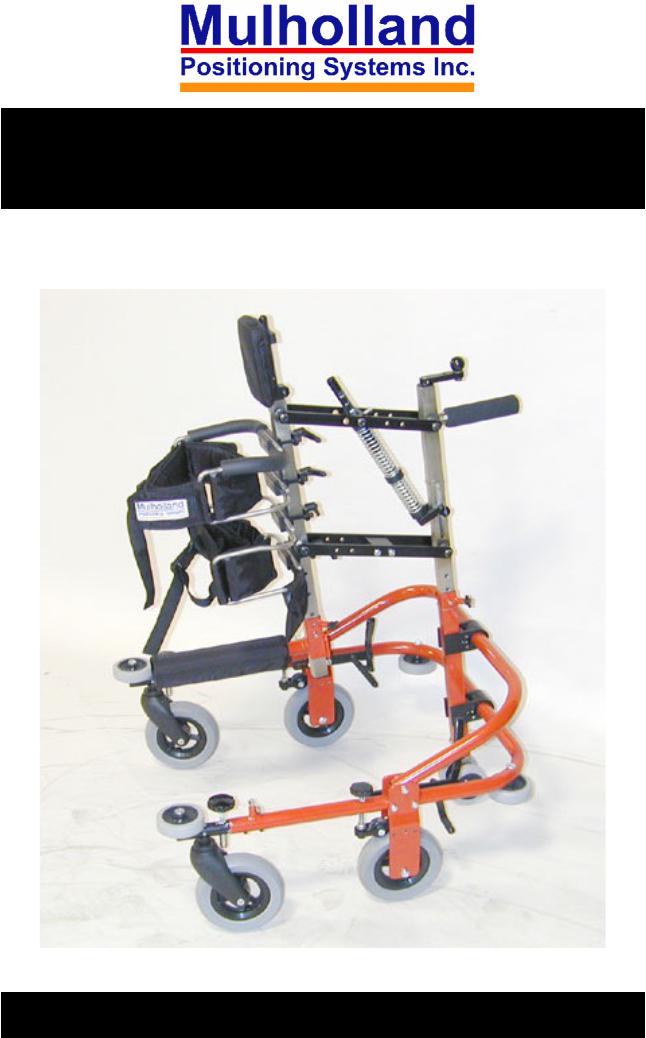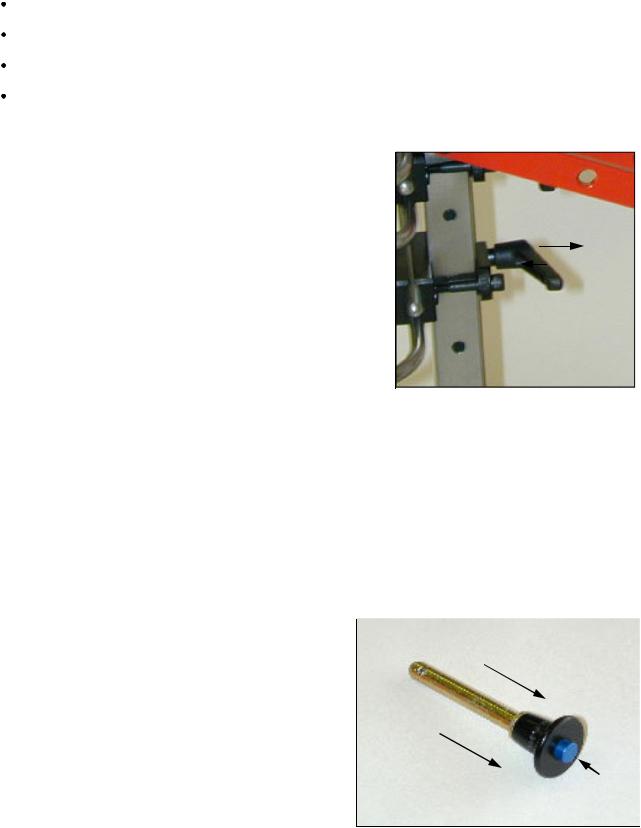Mulholland WALKABOUT 1, WALKABOUT 2 User Manual

WALKABOUTTM 1 & 2C
Use r  s Manual
s Manual
1
|
TABLE OF CONTENTS |
|
|
Preface |
3 |
|
|
|
|
Design Goals |
3 |
|
|
|
|
Precautions |
3 |
|
|
|
|
Program Recommendations |
4 |
|
P |
|
|
Components |
4-5 |
|
|
|
|
Assembly |
6-8 |
|
|
|
|
Adjustment Overview |
9 |
|
|
|
|
Fitting Instructions |
10-15 |
|
|
|
|
Measure the Child |
10 |
|
|
|
|
Sit Bar, Hip & Upper Trunk Supports |
10-11 |
|
|
|
|
Upper Body Pitch |
11 |
|
|
|
|
Column Height |
12 |
|
|
|
|
Spring Tension |
13 |
|
|
|
|
Swivel Caster Lock |
14 |
|
|
|
|
Adjustable Length Base |
14 |
|
|
|
|
Headrest |
15 |
|
|
|
|
No-Back Brakes |
15 |
|
|
|
|
Options |
16-21 |
|
|
|
|
Hand Holds & Arm Troughs |
16 |
|
|
|
|
Clear Tray Assembly |
17 |
|
|
|
|
Double Sit Bar |
18 |
|
|
|
|
Abduction Skirt |
18 |
|
|
|
|
Unicycle Saddle Seat |
19 |
|
|
|
|
Neckrest |
20 |
|
|
|
|
Shoulder Pads |
20-21 |
|
|
|
|
Operating Precautions |
22 |
|
|
|
|
Maintenance |
22 |
|
|
|
2 |
Technical Data |
23 |

PREFACE
This booklet provides the information required for the set up and use of the WalkaboutTM 1 & 2C. The benefits of using this system can be profound, not only in terms of gait development, but also in terms of increasing the child s independence, self confidence and social interaction.
s independence, self confidence and social interaction.
DESIGN GOALS
The WalkaboutTM is designed to give a child the potential for hands-free, self-initiated movement while providing lateral support and assisted lift. This spring-assisted lift allows for graduated weight relief as the child develops skill and standing tolerance. The adjustable  pitch
pitch of the column, along with the pelvic and trunk supports, can be utilized to direct weight shift and assist with stepping.
of the column, along with the pelvic and trunk supports, can be utilized to direct weight shift and assist with stepping.
PRECAUTIONS
1. This stander should be used under the prescription of the child s physician and under the direction of the child
s physician and under the direction of the child s therapist. Often, ankle support is required prior to utilization of this equipment.
s therapist. Often, ankle support is required prior to utilization of this equipment.
2. Never leave the child unattended! Maintain adult supervision at all times.
3. This stander is designed for use on level surfaces only. 4. Do not use for transportation.
5. Adjust the frame length to suit conditions of use. A short base used during play or out-of-doors can be unstable.
6. Periodically check and tighten all loose fasteners. Loose fasteners can cause the WalkaboutTM to be inoperable.
3
PROGRAM RECOMMENDATIONS
Initially, many children use the WalkaboutTM as a stationary stander to develop standing tolerance and to develop hip and knee extension. Remember that spasticity has nothing to do with strength. A child with weak hip flexors may utilize their adductors to assist (this is not a good thing!) This situation can become more severe if the child has limited dorsiflexion. Try activities such as kicking or marching.
Arrange obstacle courses to develop motor planning skills. Whenever possible, integrate the child while in the
WalkaboutTM into peer appropriate activities: soccer,  T
T ball, family
ball, family  chores
chores , ice-skating, etc.
, ice-skating, etc.
COMPONENTS
Refer to figure 1.
1. Pelvic support
2. Trunk support
3. Front column
4. Head rest
5. Spring stop assembly
6. Crank
7. Rear column
8. Tube adjustment clamps
9. Column brace 10.Base frame
11.Anti-tipper wheels 12.Toggle brake 13.Sit bar
4

4 6
5
3
2 |
7 |
|
1 
8
9
13 |
10 |
12 11
Figure 1
5

ASSEMBLY
Tools Required:
3/16 allen wrench (included in pouch)
allen wrench (included in pouch)
5/32 allen wrench (included in pouch)
allen wrench (included in pouch)
1/4 allen wrench (included in pouch)
allen wrench (included in pouch)
Tape measure
Adjustment Levers:
Refer to figure 2.
The adjustment levers can be
ratcheted so the handle can rotate without affecting the tightness of
the screw.
1. Pull out on black knob. Rotate the handle so it is not obstructed.
2. Release the black knob, and let the handle slide back and lock with the screw.
3. Continue tightening/loosening the screw by rotating the handle.
Ball Lock Pins:
Refer to figure 3.
1. Hold the head of the pin between your index and middle fingers.
2. Press in on the button (1) with your thumb while extracting or inserting the pin.
1
Figure 3
6

Assembly Instructions:
Column Adjustment Tube: Refer to figure 4
1. Place the base assembly on the floor.
2. Loosen the four allen screws on the tube adjustment clamps (1).
3. Slide the column adjustment tube (2) through the tube clamps.
4. Tighten all four allen screws on the tube clamps.
1
3
Anti-Tipper: Refer to figure 4
1. Remove the ball lock pin (3) from the column adjustment tube.
2. Adjust the anti-tipper wheels so they are 1 to 2
to 2 from the ground
from the ground
Spring Stop Assembly: |
|
Refer to figure 5 |
|
1. Remove the ball lock pin (1) and |
|
attach the bottom end of the spring |
|
stop assembly (2). |
|
2. Reinsert the ball lock pin, to secure |
1 |
it into place. |
2
Figure 5
7

Column: |
|
|
|
Refer to figure 6 |
1 |
2 |
|
1. Loosen the T-nut (1) and |
|||
|
|||
|
|
||
remove the ball lock pin |
|
|
|
(2). |
|
|
|
2. Slide the rear column into |
|
|
|
the column adjustment |
|
|
|
tube. |
|
|
|
3. Replace the ball lock pin |
|
|
|
and tighten the T-nut to |
|
|
|
lock the column assembly |
|
|
|
in place. (Keep reading |
|
|
|
for further instructions on |
|
Figure 6 |
|
fine tuning.) |
|
||
|
|
Completed Assembly:
Refer to figure 7
Figure 7
8
